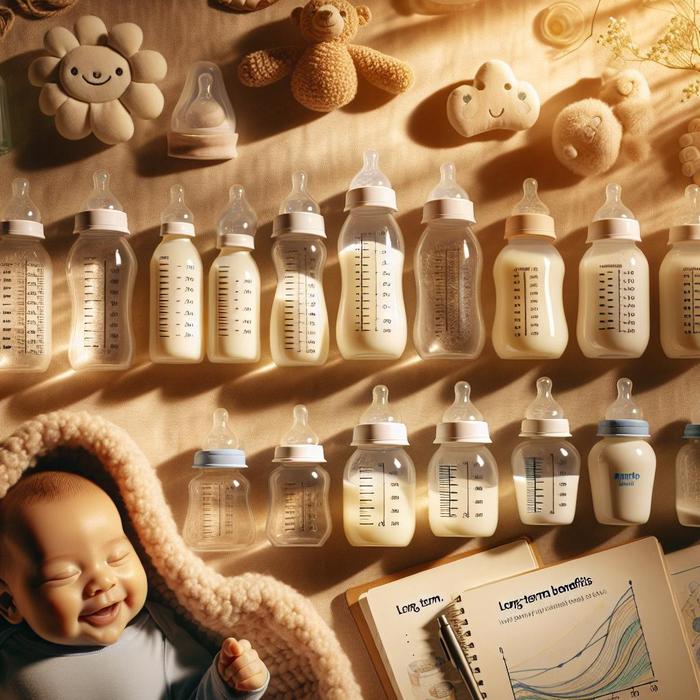Understanding the Long-Term Benefits of Baby Bottles
The task of selecting the right baby bottle for your little one might seem insignificant in the grander scheme of parenting. However, the implications of this choice are much more profound than they appear at first glance. By choosing the right baby bottle, you are not only ensuring a comfortable feeding experience for your child but also contributing to their long-term health and development.
The Impact of Baby Bottles on Infant Health
When it comes to feeding your baby, the bottle you choose plays a pivotal role in your child’s overall health. Picking the right bottle can successfully prevent feeding-related issues such as gas, spit-up, and colic, which are common in babies. Additionally, specific bottle designs can also aid in preserving the nutrients in the formula or breast milk, ensuring your baby gets the maximum benefits from each feeding.
Long-Term Benefits of Choosing the Right Baby Bottle
While the immediate advantages are significant, the long-term benefits of choosing the right baby bottle are even more compelling. Here are some major ways this choice can positively impact your child’s future:
- Dental Health: Certain bottle types can significantly reduce the chances of developing tooth decay in children. This is especially true for bottles that discourage prolonged feeding sessions and overnight feeding, known to be primary causes of ‘bottle mouth’ decay.
- Muscles and Motor Skills: The act of feeding from a bottle engages a variety of muscles in the baby’s mouth and face. A bottle with an appropriately sized and shaped nipple will ensure the correct muscles are worked, aiding in their development. This contributes to the development of essential motor skills like swallowing and chewing.
- Transitioning to a Regular Cup: A well-chosen bottle can make the transition to a regular cup smoother. Some bottles are designed to train babies for cup drinking, helping them adapt to the change easily and more naturally.
Tips for Choosing the Right Baby Bottle
Given the considerable long-term benefits baby bottles can bring, it’s crucial to make an informed decision. Here are a few tips to help you make the right choice:
- Material: Baby bottles are primarily made out of three materials: glass, plastic, and stainless steel. Each has its pros and cons, so it’s crucial to choose a bottle material that suits your lifestyle and your baby’s needs best.
- Shape and Size: Bottles come in a variety of shapes and sizes. Choosing the correct size can prevent overfeeding or underfeeding. As your baby grows, they will need larger bottles to match their increased appetite.
- Nipple Type: The bottle’s nipple plays a crucial role in your baby’s feeding experience. Nipples come in different flow rates and materials. Choosing the nipple with the correct flow rate can help prevent feeding issues like choking or gulping air.
- Ease of Cleaning: Baby bottles should be cleaned and sterilized after each use to keep them safe for your baby. Choose bottles that are easy to clean and dry, thus preventing bacterial growth.
Remember, what works best for one baby may not necessarily work best for another. It’s essential to try different options and see which one your baby prefers.
Optimizing Your Baby’s Feeding Experience
Regardless of the bottle you choose, ensuring that your baby has a positive feeding experience is paramount. Whether you are managing exclusive pumping or mastering the art of bottle feeding, understanding your baby’s needs and properly managing their feedings will promote a healthier, happier baby.
Choosing the right baby bottle might seem like a small step, but it has far-reaching implications. The benefits of making an informed choice will serve your child well into their future, making this decision one of the most important you’ll make in your child’s early life.
How the Right Baby Bottle Aids in Breastfeeding
The breast-or-bottle conundrum is one that every new parent encounters. The World Health Organization recommends exclusive breastfeeding for at least six months. However, this may not be feasible for every parent due to various reasons such as low milk production, certain medical conditions, or work commitments. In such scenarios, a bottle becomes indispensable.
Choosing the right baby bottle can make the transition between breast and bottle smooth and hassle-free. Further, using bottles specially designed to mimic the natural shape and feel of the mother’s breast can facilitate switching between the two feeding methods without confusing the baby.
Bottle Feeding: The Role of Temperature and Flow
While feeding the baby, it’s not just the type of bottle, but also the temperature of the milk and the flow of the nipple that need proper consideration. A baby who is accustomed to breastfeeding may refuse the bottle if the milk’s temperature significantly differs from the body temperature they are familiar with from breastfeeding.
Some discussions suggest that the temperature can vary from lukewarm to room temperature and would still be acceptable. However, it’s essential to note that abrupt changes from warm breast milk to cold formula might be unpleasant for the baby.
The flow of the nipple is equally significant. Certain research suggests that babies feeding on bottles with slow-flow nipples gain weight more gradually, thus reducing the risk of obesity in later life. Moreover, a fast-flow nipple might make the baby gulp air, leading to discomfort and gas.
Discontinuation of the Bottle
As important as it is to introduce a bottle to your baby, it is equally crucial to know when and how to discontinue it. According to the American Academy of Pediatrics, it’s advisable to start weaning the baby off a bottle by their first birthday. Extended use can lead to the risk of tooth decay and may make it difficult for the child to transition to healthier drink containers such as cups.
Switching from a bottle to a cup can promote muscle development in the mouth and improve hand-to-mouth coordination. For detailed guidance on discontinuing the bottle, you can use a resource like the Healthy Children project by the American Academy of Pediatrics.
Final Thoughts
The journey from breastfeeding to bottle feeding, and eventually to a regular cup, is extensive and sometimes challenging. But with the right research, understanding and most importantly, patience, it is entirely doable and even enjoyable.
Remember, every child is unique. It’s crucial to respect their timing and comfort while making these transitions. After all, your child’s happiness and health are of utmost importance.
“Babyhood is all about the small details – every little one counts.”

